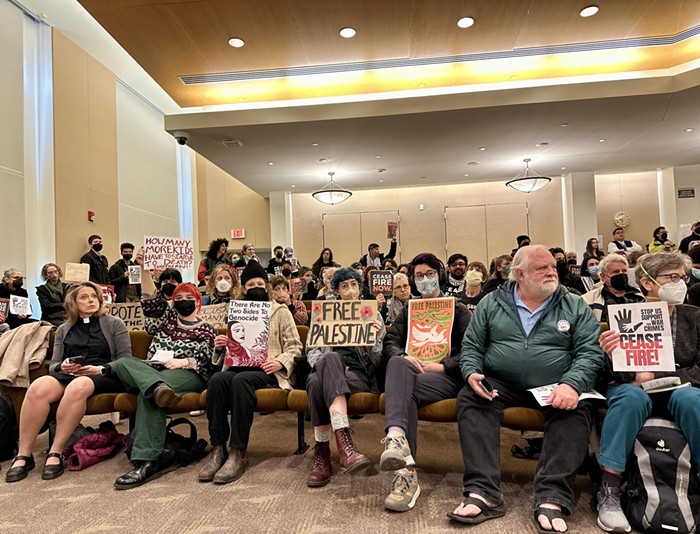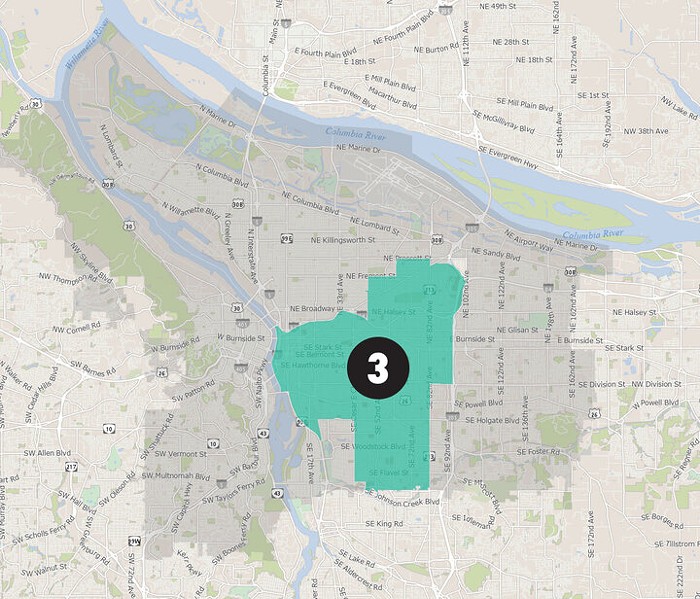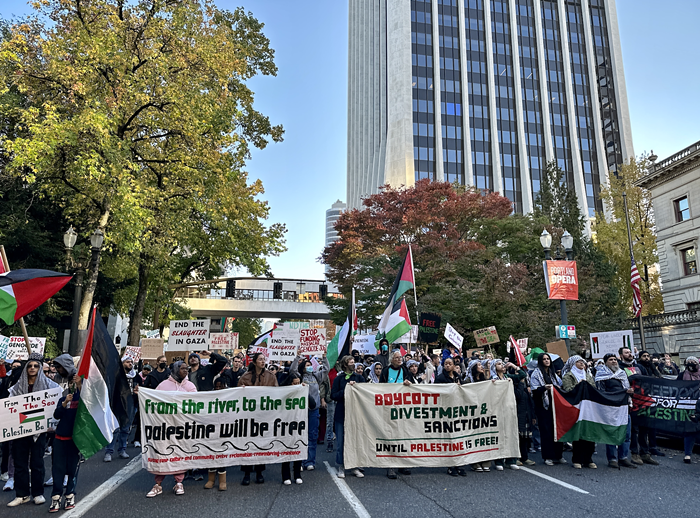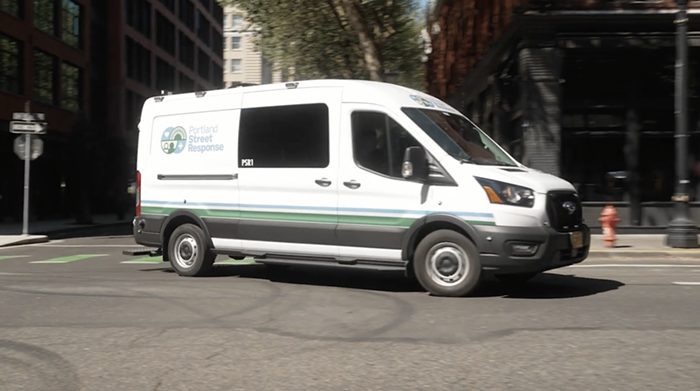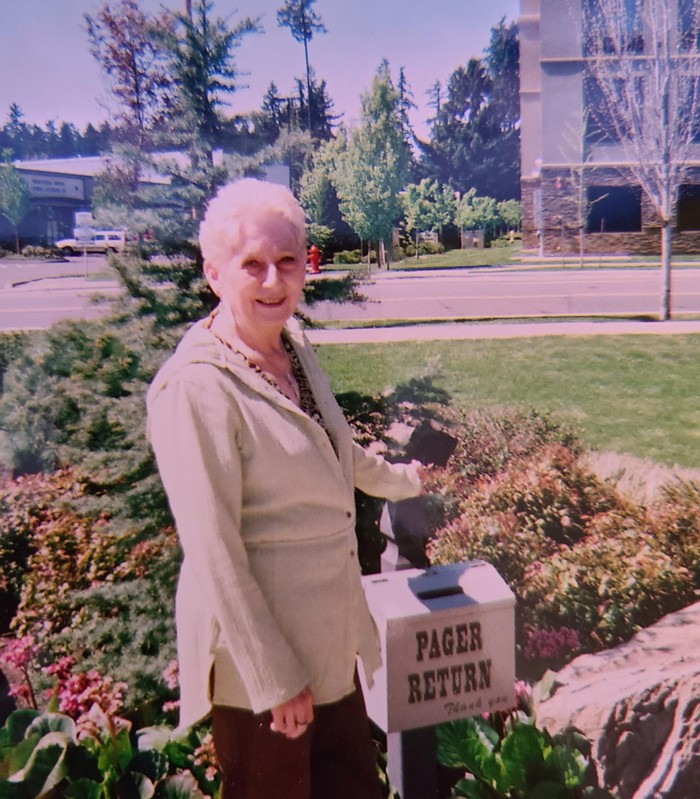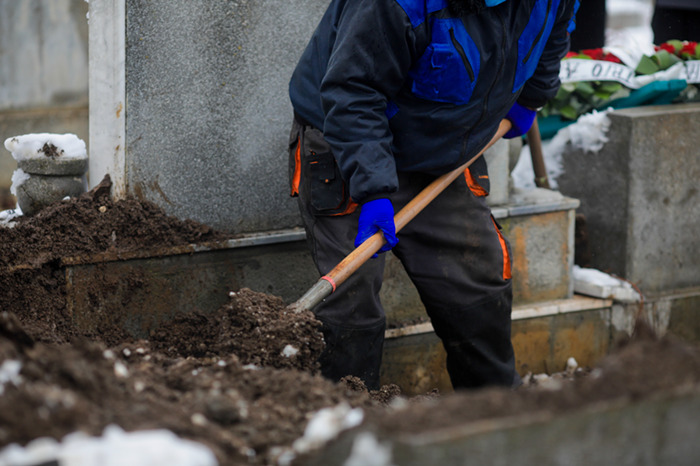Brayan Solís Mendoza’s life is unremarkable.
On break from community college classes, the 21-year-old spends his days watching soccer on TV, texting his friends, babysitting his cousins, and wiping tables at his family’s restaurant. Mendoza lives with his grandfather and step-grandmother in Madras, a high desert town in Central Oregon that’s surrounded by sagebrush, farmland, and dry canyon cliffs. Without a driver’s license, Mendoza rarely travels outside the rural community, located an hour north of Bend and two and a half hours southeast of Portland.
“I’m doing absolutely nothing,” Mendoza says with a laugh, sitting in his grandparents’ living room on a hot June afternoon. “Nada.”
It’s this seemingly mundane existence that Mendoza has spent the past year fighting to obtain.
Mendoza is one of the 218,000 immigrants who requested asylum in the United States in 2018. Fleeing gang violence in his hometown of Guadalajara, Mexico, Mendoza chose to make the solo journey to his grandparents’ home in Madras in May 2018. Twelve months later, he was granted temporary resident status by a federal judge—something that, in 2018, only 30 percent of asylum seekers received.
The increased public awareness of the long-running national humanitarian crisis on the border has given the world a startling view into how our government treats immigrants who seek refuge in the US. But for all the stories, photographs, and arguments, there are still many pieces of the country’s lengthy immigration process that remain unknown to those on the outside.
Mendoza’s story—which he told to the Mercury through a translator—shines a light on the darker corners of the American immigration system.
THE MURDERS
Mendoza’s childhood in Guadalajara wasn’t unlike growing up in suburban America. His parents, Victor and Dominga, and his younger sister, Joselyne, lived in a residential neighborhood, not far from his aunt and uncle’s house. Mendoza spent his days going to school and playing with Joselyne and their cousin..
“I told her everything,” Mendoza says of Joselyne. “She told me everything. We were very close.”
When he was young, Mendoza’s parents bought the property next to their home, where they built a small house that his maternal grandmother moved into. When his parents decided to move to a town outside of Guadalajara in 2014, the 16-year-old Mendoza moved in with his grandmother so he could continue attending his nearby high school. At the time, his parents said they had to move because Joselyne was having nightmares when she slept in their family home.
Only later did Mendoza realize the real reason his family left: They were receiving death threats from one of Mexico’s largest cartels.
Like any major cartel, Jalisco New Generation Cartel acquires power through gaining wealth—whether that’s by obtaining a new business, making a profitable narcotics deal, or seizing land. The cartel, whose financial support of state police kept them immune from arrest, demanded Mendoza’s parents hand over their property. They refused.
Mendoza was unaware of the battle over his family’s home until April 2018. He recalls his grandmother shaking him awake.
“She said, ‘Wake up! They shot your father!’” Mendoza says. He ran outside and saw his cousin Oscar, who pointed down the street to his family’s car, parked in the middle of the road.
By the time Mendoza reached the passenger window, he knew his parents were dead. His father’s face and chest were riddled with bullets. His mother’s intestines spilled from her body. Joselyne, in the backseat, was still breathing. Mendoza jumped into the car and wrapped his arms around her as she slowly died from her gunshot wounds. Mendoza’s voice shakes when he describes the last moments with his family.
“I didn’t want to leave. I was abandoning my dreams, my family, my school. But my life wasn’t safe anymore.”
“I remember walking back into my house, looking in the mirror, and saying, ‘I’m dreaming, I’m dreaming,’” he says. “But then I saw my clothes covered in blood. I heard the sirens. I knew it was real.”
Mendoza says the police never asked to speak with him and did little to investigate the murders. Days after his family’s funeral, he began receiving death threats from an unknown number. After his parents died, their property was transferred to his name, making him the next target of the land-hungry cartel. (Mendoza says his grandmother wasn’t threatened by the cartel, which he believes is because the property isn’t in her name.)
Knowing the police favored the cartel—which had eyes across all of Mexico—Mendoza realized he had no choice but to leave.
Mendoza, 19 at the time, had never traveled on his own and knew nothing about what it took to enter a different country. But he knew his paternal grandfather lived in a distant corner of the United States, and he knew how to get to the border.
So Mendoza loaded his backpack, tearfully hugged his grandmother goodbye, and boarded a bus to Tijuana.
“I didn’t want to leave,” Mendoza says. “I was abandoning my dreams, my family, my school. But my life wasn’t safe anymore.”
THE BORDER
Two days later, Mendoza arrived in Tijuana.
“I was like, ‘I’m here. What do I do now?’” Mendoza says. A family friend directed him to the San Ysidro Port of Entry, the United States’ busiest international border crossing.
When he arrived, however, a border agent told him the wait would be long and suggested Mendoza instead try to cross at Otay Mesa, a less-popular entry point nine miles to the east.
It was mid-afternoon on May 22, 2018, when Mendoza’s taxi dropped him off at Otay Mesa. Mendoza walked up to the US Customs and Border Protection (CBP) kiosk, and told the agent inside that he was seeking political asylum. The agent said he’d help, and that he’d return in 20 minutes. Mendoza never saw him again.
Mendoza spent the next 48 hours on the concrete outside the CBP office, holding his place in line alongside dozens of other strangers seeking refuge.
“We felt like trash,” he says. “We watched many other people with passports easily walk through [the entry point], and we just wanted our opportunity.”
He met a pregnant woman traveling alone, a family of four, and a tired woman covered in bruises who, along with her nine-year-old son, was escaping an abusive husband in Peru. Her suitcase had been stolen while traveling through Mexico. Mendoza bought them tacos from a nearby food truck and tried to comfort her son, who kept bursting into tears.
“He said, ‘I don’t want to leave my school, my country, my friends,’” says Mendoza. “And I told him, ‘That’s exactly how I feel. You and I are the same.’”
“I told him, ‘You are too young to understand why your mom needed to leave, but things are going to be better,’” Mendoza adds. “Even though I had no idea what was going to happen on the other side.”
A day later, a CBP officer told Mendoza it was finally his turn to meet with a CBP agent inside the building. Mendoza let the Peruvian mother and son go in his place.
On May 24, after two days without sleep, Mendoza was called again. An agent let him inside the building and directed him to a sterile waiting room.
“I thought my experience was going to improve,” he says, “but it only got worse and worse.”
He spent two more days sitting in this room. The morning of May 26, an agent called Mendoza into another room for a brief interview, the first official step in the American asylum-seeking process that intends to establish if an immigrant’s concerns of persecution or harm are legitimate. Mendoza was asked why he wasn’t able to safely wait in Mexico until his asylum request was processed. When the agent seemed convinced by Mendoza’s answer, he was handed a thin, silver Mylar blanket, the kind given to marathon runners after completing a race.
“The agent told me, ‘This is going to keep you nice and warm,’” says Mendoza. “I looked at him like he was crazy.”
Then he entered the holding pen. Called hieleras, or “iceboxes,” by those who have spent time in them, these rooms in border crossing facilities are notorious for being windowless and overly air-conditioned. Mendoza recalls the hielera being the size of an average living room, with its cold, tiled floor littered with discarded Mylar blankets. He shared the space with around 30 others seeking asylum, including immigrants from China, Russia, Armenia, and numerous Latin and African countries. People huddled next to whomever could speak their language.
Mendoza struggled to sleep. The CBP agents gave them no information about how long they’d be there or where they’d go next.
Nearly every immigrant who asks for asylum at the border and passes their credible fear interview is eventually placed in a jail-like detention center, the majority of which are located along the US-Mexico border. Unless the detainee can post bail, they remain in these locked facilities until their case is reviewed by an immigration judge. Because of the US’ currently overloaded immigration system, this waiting period can take years.
On May 31, five days after entering the hielera, Mendoza was put in handcuffs and leg irons and told he’d be traveling to a detention center in Tacoma, Washington.
Mendoza was herded onto a bus filled with other immigrant men headed to the San Diego International Airport, where he was put on a plane with even more handcuffed men. After landing in an unknown airport, the shackled men were led onto a bus.
Within minutes of pulling away, Mendoza saw two unusual things outside the bus window: Oregon license plates, and giant yellow letters on a blue building spelling “IKEA.” His fellow passengers didn’t know what IKEA meant, but they did know they weren’t in Washington state. After a two-hour drive, the bus pulled up behind two other buses in front of a large, off-white building surrounded by a concertina-wire fence. A sign marking the driveway to the facility read “FCI Sheridan.”
THE PRISON
It was 3 pm when Mendoza’s bus arrived at the Federal Correctional Institution outside of Sheridan, Oregon, some 50 miles southwest of Portland. But since the staff at the federal prison had to individually register the 124 immigrants occupying the three buses, Mendoza wasn’t allowed to leave the bus until five the following morning. It wasn’t until he was assigned a cell that Mendoza realized he was in a prison.
“I thought, ‘Wow, how long are they going to have us here? We haven’t done anything bad,’” Mendoza says.
No one informed Mendoza that he and his fellow newcomers were being held in a prison because, according the feds, America’s federal detention centers had run out of space. The asylum seekers had crossed into the US in the midst of an immigration crackdown by the Trump Administration—one that has divided families at the border and kept all incoming immigrants in detention for a longer period of time.
Sheridan employees had only been given a few days’ notice to prepare for the 124 incoming immigrants, who represented 16 different countries and spoke a combined 13 languages. They also weren’t advised that the Constitution gives immigrants more rights than the average prison inmate.
Mendoza and another young Latino man were locked in a cell with two beds and an open toilet. They shared a cell block with convicted felons, who spit insults at the new inmates and kicked at their cell doors.
“They said, ‘We’re going to kill you and make it look like suicide,’” Mendoza says. “We were terrified.”
Mendoza spent the next 22 days in this cell, only leaving occasionally to take short showers. Prison guards forbade them from making phone calls or obtaining legal aid—two rights guaranteed to detained immigrants in the US. Many men were denied translation services and the ability to practice their religion. Mendoza remembers hearing men crying in distant cells, sobbing and yelling out in different languages. At least one man attempted suicide.
“I don’t know how I got through it, really,” says Mendoza. “I guess I thought that since I was detained, I was safe. I had no hope of returning [to Mexico]. So I had to be patient. I just had to wait for what came.”
Some of the immigrants who entered Sheridan opted to be deported to their home countries instead of remaining in prison for what felt like an indefinite amount of time.
But they hadn’t been forgotten by the outside world. One of the detainees had somehow been able to call a family member, alerting them to the crisis inside. That person reached out to a Portland-based immigration law firm, Innovation Law Lab (ILL), whose attorneys immediately attempted to visit the men inside. They were turned away by prison staff. In mid-June, a federal public defender interviewed the men and documented the distress caused by their unconstitutional detention, lawyers working with the ACLU of Oregon filed an emergency lawsuit against the federal government, demanding instant access to the incarcerated immigrants. On June 25, it was granted.
After the lawyers’ intervention, Mendoza and the rest of the immigrants were moved to their own cell block, segregated from prisoners. Finally allowed to make phone calls, they were visited by ILL attorneys who advised them on their constitutional rights. The pro bono lawyers also worked with them to send a letter to US Immigration and Customs Enforcement (ICE) requesting bail. Like someone arrested for a crime, a detained immigrant can be released on bail if a judge is convinced that they’ll return to court to stand trial—which, in this case, is known as an asylum hearing. Mendoza met with an ILL attorney, requested bail, and called his grandparents in Madras, who had expected him weeks ago.
By mid-August, some of the men were being released on bond. But, Mendoza observed, none of those released were Latino. That’s why on August 13—four months after the murder of his mother, father, and sister—he considered giving up.
“I was tired. I thought, ‘Maybe it’s just better if I return to Mexico.’” Mendoza says. But his cellmate at the time—an older man his fellow Latino detainees called “abuelo,” or “grandfather”—kept him from doing so.
“He told me, ‘No, no, no, look at all we have been through,’” says Mendoza. “‘We are here. We are going to be released. Don’t worry.’”
He waited. A month later, on September 15, ILL received a letter from ICE granting Mendoza parole. He was released on a $1,500 bond—the minimum offered to US asylum seekers. In 2018, the median bond for immigrants seeking asylum in the US was $7,500.
If someone was able to pay Mendoza’s bond, he could be released until the feds scheduled his asylum hearing before a judge.
Mendoza’s step-grandmother got the call that afternoon. She left work early in Madras and had a friend drive her the two and a half hours to the Portland ICE office, the closest place she was able to pay Mendoza’s bond. Then she drove to Sheridan and picked up her grandson.
Five months after leaving his home in Guadalajara, and after 105 days in prison, Brayan Solís Mendoza was free.
THE HEARING
While Mendoza had left the confines of detention, the months following his release offered a different kind of imprisonment. He says his freedom felt artificial and temporary, and he feared one wrong move would send him back to Mexico.
In the meantime, Mendoza moved into his grandparents’ home, enrolled in psychology and English classes at Central Oregon Community College, and got a cell phone to contact friends and family back in Mexico. That’s how he learned the cartel had murdered his cousin, Oscar, for trying to defend his family’s property. This news only solidified Mendoza’s fear of being murdered if an immigration judge rejected his asylum request, denying him permanent citizenship and triggering his deportation.
On May 22, 2019, Mendoza’s grandparents dropped off their grandson in downtown Portland to attend his asylum hearing. He asked them not to come with him, since their attendance would only make him more nervous. He wore a crisp button-up shirt and slicked back his black hair. Jordan Cunnings and Sara Eddie, Mendoza’s two lawyers with ILL, gave him an encouraging hug before they walked into the small courtroom.
Portland’s immigration court is discreetly housed on the fifth floor of a blue-tinted federal building near Portland City Hall. The courtrooms are low-ceilinged and small, with only two rows of benches for members of the public. Unless a plaintiff specifically allows it, asylum cases are never open to the public or press, giving the hearings an oddly intimate feel. In this case, Mendoza allowed the Mercury to attend his hearing.
Mendoza’s hearing was administered by Judge Richard Zanfardino, a longtime immigration judge with a reputation for being reasonably understanding with asylum seekers. After Zanfardino discussed Mendoza’s case with the ILL lawyers and Chris Murray, the attorney representing Department of Homeland Security (DHS), the judge asked Mendoza to explain what prompted him to leave Mexico.
Mendoza detailed the events leading up to his family’s murders, pausing to allow the court translator to repeat his words in English. He wiped away tears as he detailed his parent’s death and the foggy days that followed. Zanfardino asked why, after receiving death threats, Mendoza didn’t go to the police.
“Unfortunately, the government’s for sale by the drug dealers,” Mendoza explained through the translator. “It would have put me in more danger.”
Zanfardino nodded. “What were your plans before all of this happened?”
“I was studying business administration. I was going to register to go to university in August,” said Mendoza. “I wanted to be independent. I wanted to be someone.”
The cross-examination by Murray was brief and began with this acknowledgement: “I believe he is testifying honestly.” Yet he pushed Mendoza to explain why he had to relocate to the US, prompting Mendoza to reiterate the extensive power of Mexican cartels.
After a pair of equally brief closing arguments, Zanfardino left the room. Mendoza fiddled with his wadded-up handful of Kleenex, watching the door. After 15 minutes, the judge returned.
“What I tried to do today was outline two decisions. One granting relief, one denying relief,” said Zanfardino, holding up two pieces of paper. “It was a matter of deciding what made sense to me.”
He paused.
“But the more I look at denial, I just can’t sell it.”
Mendoza was granted asylum exactly one year after he arrived at the US border. He was the first of the 124 immigrants held in Sheridan Prison to be granted temporary citizenship.
Before closing the hearing, Zanfardino reminded Mendoza that if he broke any laws before applying for permanent residency, he could be deported. Murray reached across the aisle to shake Mendoza’s hand. “I want to welcome you,” he said. “I think you’re going to make a great citizen. I think you will do something great with your life.”
In the hall outside the courtroom, Mendoza’s lawyers wiped tears from their eyes and laughed as they hugged their client.
“I couldn’t have done this without you,” Mendoza said, drying his tears on his shirt collar. “Thank you.”
A half hour after Zanfardino’s ruling, Mendoza sat on a park bench across the street from the federal building and tried to make sense of his emotions.
“When I heard the judge’s decision, I got this sensation inside of me—something I never really experienced before. The sensation that I have a future. I am going to live,” said Mendoza, beaming.
“I don’t know what to say or what to do,” he said, looking up at the sky. “I want to scream. I want to run. I feel like I can breathe again.”
THE FUTURE
Back in his grandparents’ living room in Madras, one month after Zanfardino’s ruling, Mendoza—dressed in a T-shirt with a tropical print, cuffed jeans, and black Adidas—says he can finally rest.
“I feel like a weight has been lifted from me,” he says.
Framed portraits of his relatives cover the wall behind him, and his younger cousins’ toys crowd a corner of the tidy living room. A small dog barks from the backyard. His grandparents are at work—his grandfather at a nearby logging mill, and his grandmother making tortillas, enchiladas, and carne asada at the family restaurant.
Now that school’s out for the summer, Mendoza relies on his four-year-old cousin, who also lives with his grandparents, to help teach him English. He jokes that the “only friend” he’s made in Madras is a 40-year-old woman with kids. She’s got him watching English TV shows with Spanish subtitles.
After mastering English, Mendoza intends on resuming his pursuit of a career in business administration. “I’m looking forward to building the future I wished I could have built for myself in Mexico,” he says.
In the meantime, he’s applied for a work permit so he can start saving money. He will be able to apply for permanent citizenship—also called a “green card”—next spring. Four years after obtaining a green card, Mendoza can apply for US citizenship.
Like many seeking asylum in the US, Mendoza decided to emigrate without considering what the journey would be like. “I knew I had to go,” he says, “and I wasn’t thinking about what would happen next.”
If he had known what lay ahead—sleepless nights on cold tile, shuffling through a crowded airport in shackles, and spending months locked up in an isolated federal prison—Mendoza says he doesn’t know if he would have made the trip. But was it worth it?
“Yes,” he says. “In the long term, the suffering is worth it.”
Mendoza often laughs when retelling the darkest moments of his journey, as if delivering a punchline to a joke. “In that moment, I felt like I would die,” he says, recalling his time in Sheridan. “I can’t believe what I’ve been through, and now I am here. It’s ugly, but it makes me laugh because I’ve left it in the past.”
“I’m looking forward to building the future I wished I could have built for myself in Mexico.”
Thousands of other immigrants who have embarked on journeys like Mendoza’s, however, have yet to reach their destination.
“Sometimes, when I see what’s going on now... I wonder if I waited a little longer to come, if I would have been in the same situation as people are right now,” Mendoza says.
The news around immigration is “disturbing,” Mendoza says. He was especially struck by a photo of the bodies of a father and his daughter who drowned trying to cross the Rio Grande into the US.
“I think of the suffering of the children,” he says. “If I [was] suffering, I can imagine that the children are suffering even more.”
Under the Trump Administration’s current immigration policy, many Mexican nationals must wait in Mexico, rather than the US, until their asylum hearing is scheduled. In Mendoza’s case, that would have meant remaining in Mexico for more than a year. To him, it would have been the equivalent of a death sentence.
Central Oregon still doesn’t feel like home to Mendoza. He misses his grandmother, whom he calls regularly, and dreams of one day returning to Mexico—but knows it won’t be possible for a long time. He would like to visit New York City, Los Angeles, and maybe even move to Miami. But for now, he’s happy to call Madras home.
“Sometimes I think about what things would be like had this not happened,” says Mendoza. “That I’d be in school, living my life with my parents in Mexico. But sometimes God puts things in our path, and we have to do the best that we can.”
He’s ready to leave his suffering in the past.
“This,” he says, “is the start of something good.”
Victoria Bejarano Muirhead provided translation services for this story.


